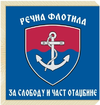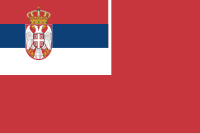Serbian River Flotilla
| River Flotilla | |
|---|---|
  River Flotilla Unit Emblem and Flag | |
| Active | March 30, 1833 – current |
| Country | Serbia |
| Branch | Serbian Army |
| Type | Brown-water navy |
| Role | Control of inland waterways |
| Size | 1,000 sailors and 400 support personnel 16 ships and boats |
| Part of | Serbian Armed Forces |
| Headquarters | Novi Sad |
| Anniversaries | August 6 |
| Engagements | First Balkan War Second Balkan War World War I World War II Croatian War of Independence |
| Commanders | |
| River Flotilla Commander | Commodore Andrija Andrić |
| Insignia | |
| Naval Ensign |  |
The Serbian River Flotilla (Template:Lang-sr) is the specific unit of the Serbian Land Forces with the task of keeping an optimum operational regime of sailing and of protection of Serbian interests in interior sailing corridors. The area consists of rivers and canals with a total length of 1,626 km. The unit is composed of the Command ship Kozara, river minesweepers and assault loading boats. The command of River Flotilla is based in Novi Sad, as is most of its units, except for those based in Belgrade and Šabac.
History
Origins
The Šajkaši flotilla of the last Serbian Despot, Pavle Bakić, fought against the Ottomans.
On March 30, 1833, the Serbia set sail. It was built at Dubravica shipyard by Greek Nikola Kefala by order of Knjaz Miloš (TT information: length 24m, breadth 7m, draughts 3,5m, carrying capacity 250t). In April 1840, the Knjaz Mihailo was constructed in Brza Palanka (TT information: length 65m, breadth 7,5m, draughts 4,5m, armament of ship was 12 cannons).
World War I
Serbia received its first true warship, the patrol boat Jadar, on August 6, 1915. It was built in Čukarica. The ship was armed and used for mine laying on the Sava river. On the Danube, during World War I, the armed tug Stig protected Russian convoys coming to the port of Prahovo against Austro-Hungarian aircraft until October 1915, when Stig had to be scuttled after the Bulgarian invasion.[1]

Kingdom of Yugoslavia and World War II
The Royal Yugoslav Navy in its organization had a River flotilla composed of a command ship Cer based in Novi Sad, one monitor group in Dubovac, four mining-barrage groups in Bezdan, Stara Kanjiza and Senta, Sremski Karlovci and Smederevo and Đerdap sector command in Tekija and Donji Milanovac. The main vessels were four large, heavily armed and armoured river monitors. They were used to patrol the Danube, Drava and Sava rivers in the northern parts of Yugoslavia and its border with Hungary. These monitors, the Drava, Sava, Morava and Vardar had been inherited from the Austro-Hungarian Navy at the end of First World War. All were of around 400-500t with a main armament of two 120mm guns, two or three 66mm guns, 120mm mortars, 40mm AA guns and machine guns. The River fleet also had two river patrol boats built in 1929, Graničar and Stražar, and three river tugs.
At the start of the April War river monitors had carried out offensive operations by shelling the airfield at Mohács in Hungary on the 6th of April and again two days later, but had to begin withdrawing towards Novi Sad by the 11th of April after coming under repeated attack by German dive-bombers. Early in the morning of 12 April, a squadron of German Junkers Ju 87 dive-bombers attacked the Yugoslav monitors on the Danube. The Drava was hit by several of them but they were unable to penetrate the vessel´s 300mm thick deck armour, until, by chance, one put a bomb straight down the funnel, killing 54 of the 67 man crew. During the attack, anti-aircraft gunners on the monitors claimed three dive-bombers were shot down. The remaining three monitors were scuttled by their crews later on 12 April as German and Hungarian forces had occupied the bases and the river systems upon which they operated.[2]
Organization
- River Flotilla
- Command Ship Cer - Novi Sad
- 1st Monitor Group - Dubovac
- 1st Mining-Barrage Group - Bezdan
- 2nd Mining-Barrage Group - Stara Kanjiza and Senta
- 3rd Mining-Barrage Group - Sremski Karlovci
- 4th Mining-Barrage Group - Smederevo
- Đerdap sector command - Tekija and Donji Milanovac
River Fleet Ships
River Monitors Ex-Austro-Hungarian Navy river gunboats/monitors:[3]
- Vardar (1915)
- Sava (1915)
- Drava (1915)
- Morava (1915)
River Patrol Boats
- Graničar (1929)
- Stražar (1929)
River Tugs
- Šabac
- Sisak
- Cer
River flotilla of Yugoslav Partisans
On September 11, 1944, in Neštin, by Order of General staff of NOV i PO in Vojvodina, the Naval company was formed, the first official naval unit at Danube and Sava, a part of the 11th Vojvodina NOV brigade. The men came from the ship Zagreb, signal-corps troops from the General staff of Vojvodina and soldiers from different units who had earlier served in the navy. The Zagreb was a passenger ship rearranged for mine disposal, serving the German military. It came under Partisan control after a Partisan portion of the crew captured it. This action was led by deputy commander of Zagreb Dragutin Iskra. The crew brought all light arms and 20mm anti-aircraft cannon with them. The Naval Company's first commander was Kara Dimitrijević from Ledinci, deputy commander was Dragutin Iskra, political commissary Svetozar Milovanović, and deputy of political commissary Rada Prodanović. The troop had 70 to 80 soldiers and it had a duty to attack enemy river traffic and to do transports at Danube. It was based on three places at Fruška Gora: at Testera, near Neštin and Krčedin.
On November 20, 1944, a navy base was formed in Novi Sad, and this troop was a part of the base. After a little bit more than two months of existence, the troop severely damaged five and lightly damaged forty-three enemy boats. At the same time, it transported 220,000 soldiers over the Danube, about 2,000 cannons, 3,000 trucks and also other material.
In March, 1945, the flotilla consisted of seven patrol boats, nine motor boats and seven assault boats. By mid-April, it was reinforced with five more ships and the command ship Cer. From ships and boats based in Sremska Mitrovica the Sava flotilla was formed on 20 March 1945, and on 14 April ships and boats from the base at Novi Sad formed the Danube flotilla.
After World War II
In the period from 1944 to 1965, the river flotilla was organized in a few detachments of armored river boats, river assault ships, river auxiliary ships and minesweepers in a squadron as part of Yugoslav Navy (JRM).
From 1960 the flotilla was excluded from the Navy and subordinated to the 1st Army, but during later reorganization it again became part of the Navy.
The period from 1965 to 1984 was characteristic of technical modernization and perfecting of tactics of using RF. Minesweepers type 319 and 307 and assault ships type 401 were reconstructed, new minesweepers type 331 were built, a station for demagnetization of ships and the ships were rearmed.
Breakup of Yugoslavia
The last combat operation of the flotilla was on November 8, 1991, during the war in Croatia, when the Botica-class minesweeper RML-308 was sent to Kopački Rit to intercept the Czechoslovakian towboat Šariš, which was smuggling arms to Croatia. The minesweeper was ambushed by Croatian forces, and attacked with Zolja and Armbrust anti-tank rockets. 1st class Warrant Officers, Lampret Kristijan and Marković Stevan were killed while commander Zoran Marković was wounded by a sniper. Although seriously wounded, he managed to get the stranded boat to shore with the help of several sailors and save the crew and the ship from sinking. Šariš´s wheelhouse was damaged by 20mm gunfire from RML-308 and one of the boat's fuel tanks was hit and burst in flames.[4]
With breakup of Socialist Yugoslavia, the remaining Yugoslav People's Army was transformed by 1992 into Military of Federal Republic of Yugoslavia. The River Flotilla remained as part of Navy. During the 1990s one new Neštin class river minesweeper introduced in 1996, and two class 601 assault ships have been transferred from sea service at Montenegro to River Flotilla after being overhauled at "Brodotehnika" shipyard in Belgrade.
After the reorganization of the Serbian Military, the River Flotilla was organizationally subordinated to the Land Forces, as the military didn't have a naval branch anymore. The Flotilla is now organized as a Brigade-size unit, with two pontoon battalions from 1st Land Force Brigade subordinated to it.
Modern River Flotilla
Following the separation of Serbia and Montenegro in 2006, the river flotilla became subordinate to the Serbian army. The river flotilla's primary responsibilities are the control of inland waterways on the Danube and Sava rivers and coordination and transportation of Serbian Army units across inland waterways.
Organization
- River Flotilla Command – Novi Sad
Equipment
Vessels
- RPB-30 Kozara
 Austria
Austria
- RPB-30 Kozara
Degaussing ship
- RSRB-36 Šabac
 Yugoslavia
Yugoslavia
- RSRB-36 Šabac
- Neštin-class
 Yugoslavia
Yugoslavia
- RML-331 Neštin
- RML-332 Motajica
- RML-335 Vučedol
- RML-336 Đerdap
- RML-341 Novi Sad
Assault ships
- 441-class
 Yugoslavia
Yugoslavia
- DJČ-411
- DJČ-412
- DJČ-413
- DJČ-414
- ČMP-22
 Yugoslavia
Yugoslavia - ČMP-23
 Yugoslavia
Yugoslavia - ČMP-24
 Yugoslavia
Yugoslavia - RPČ-111
 Yugoslavia
Yugoslavia - RPČ-213
 Yugoslavia
Yugoslavia - RPČ-214
 Yugoslavia
Yugoslavia - RPČ-216
 Yugoslavia
Yugoslavia
- ČMP-22
Other equipment
Gallery
-
RSRB-36 "Šabac"
-
RSRB-36 "Šabac"
-
RSRB-36 "Šabac"
-
DJČ-412 assault boat
-
DJČ-412 assault boat
-
RPČ-214 patrol boat
See also
References
- ^ Was there a Serbian Navy? by René Greger. From Warship, Volume VIII, 1984. Naval Institute Press, pp. 100-101. ISBN 0-87021-983-9
- ^ Shores, et al, 1987, p. 224.
- ^ Shores, et al., 1987, p. 224.
- ^ Dunaj Ondrejkovics - Sandor de Szlavnicza files Template:Sk icon







